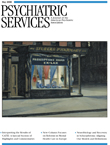Use of antipsychotic medications exemplifies psychiatrists' need to make high-risk treatment decisions in the face of uncertainty. In North America in the early 1990s, most antipsychotics in use were first-generation agents, such as haloperidol. These medications were often poorly tolerated, with distressing extrapyramidal side effects and the risk of tardive dyskinesia. Only one second-generation antipsychotic—clozapine—provided an alternative, but it carried the risk of toxic side effects, such as agranulocytosis.
Hope appeared in the form of other second-generation antipsychotics—risperidone in 1994, olanzapine in 1995, and quetiapine in 1997. Many patients appeared to tolerate them better than traditional agents. The next few years revealed an unexpectedly high prevalence and severity of weight gain, hyperlipidemia, and diabetes from use of second-generation antipsychotics.
This issue of Psychiatric Services features a special section on interpreting the results of Clinical Antipsychotic Trials of Intervention Effectiveness (CATIE). CATIE and a similar study in the United Kingdom—CUtLASS (Cost Utility of the Latest Antipsychotic Drugs in Severe Schizophrenia)—failed to find substantial differences in clinical outcome between first- and second-generation antipsychotics. Should we have questioned spending a hundred times more for second-generation antipsychotics in order to have a different side-effect profile and more medication choices? What can psychiatrists learn from this experience?
We professionals share the human tendency to embrace fads. We shift between psychosocial and neurobiological paradigms when an ongoing balance would better serve everyone.Objectivity depends on having independent resources and authority to oversee the conduct of clinical trials with human subjects and the analyses of resulting data. Hidden and vague agendas, including profit motives, undoubtedly influence psychiatric research, publication, and practice. For the process to be truly "evidence based," it must be transparent.
Tradeoffs related to clinical effectiveness, safety, adverse effects, and cost strike a balance between these important factors, but tradeoffs are not solutions. We must therefore strive for optimum balance and transparency by increasing collective awareness of these tradeoffs and by anticipating risks, benefits, alternatives, and costs about which we cannot be certain. And we must share the uncertainties with our patients. Informed consent helps to ensure that patients are aware of their options for treatment, including no treatment, and of how their preferences and individual characteristics might influence their quality of life. Increasing patients' participation in informed decision making empowers both patients and their clinicians and respects patients' autonomy.

